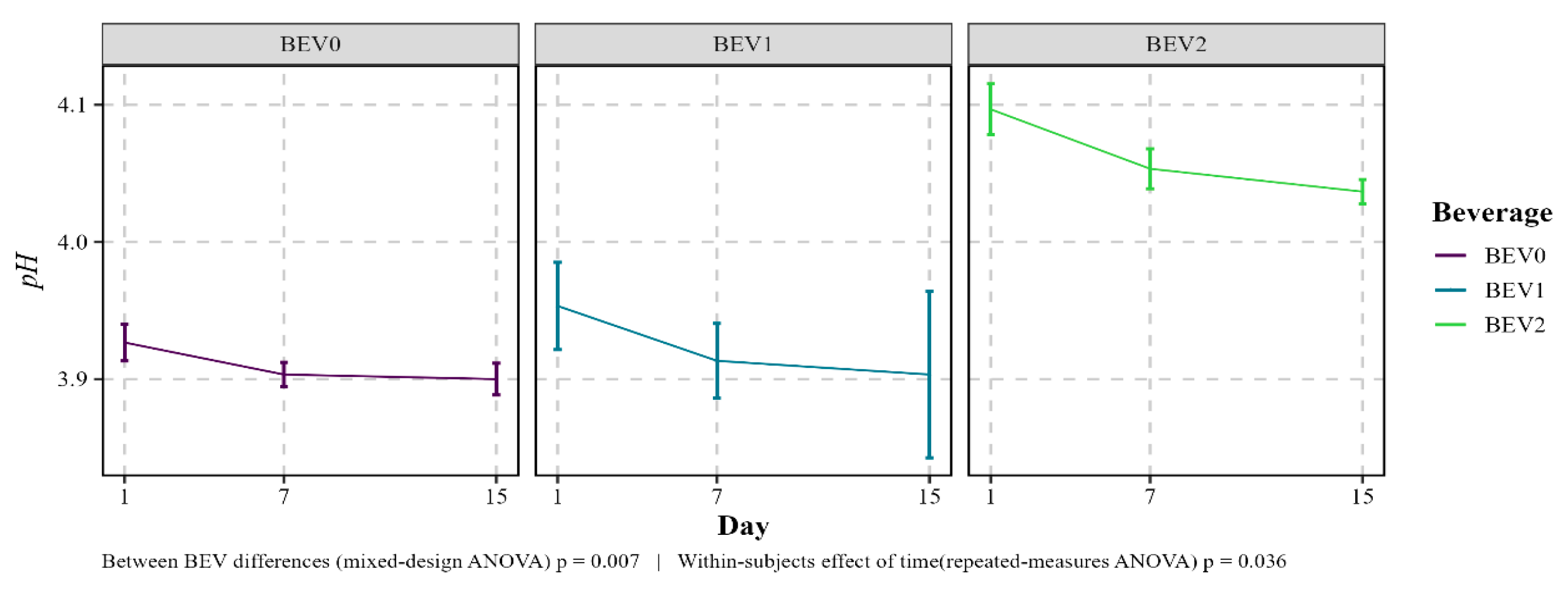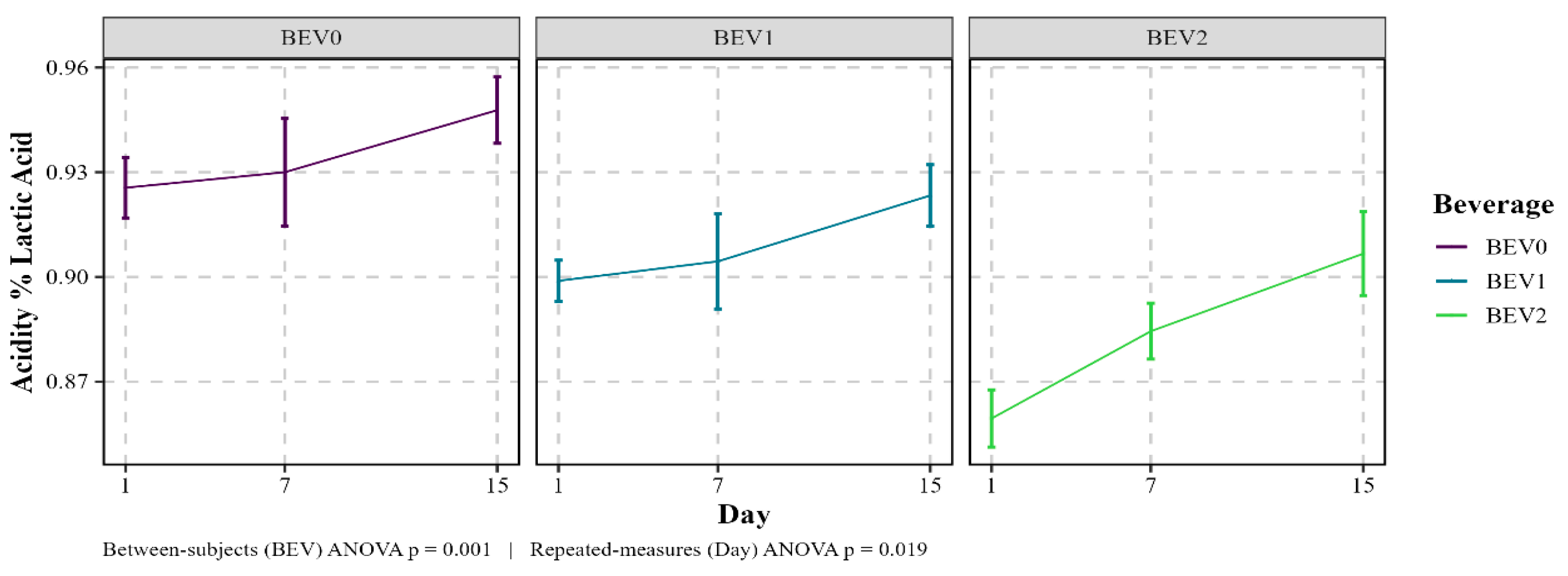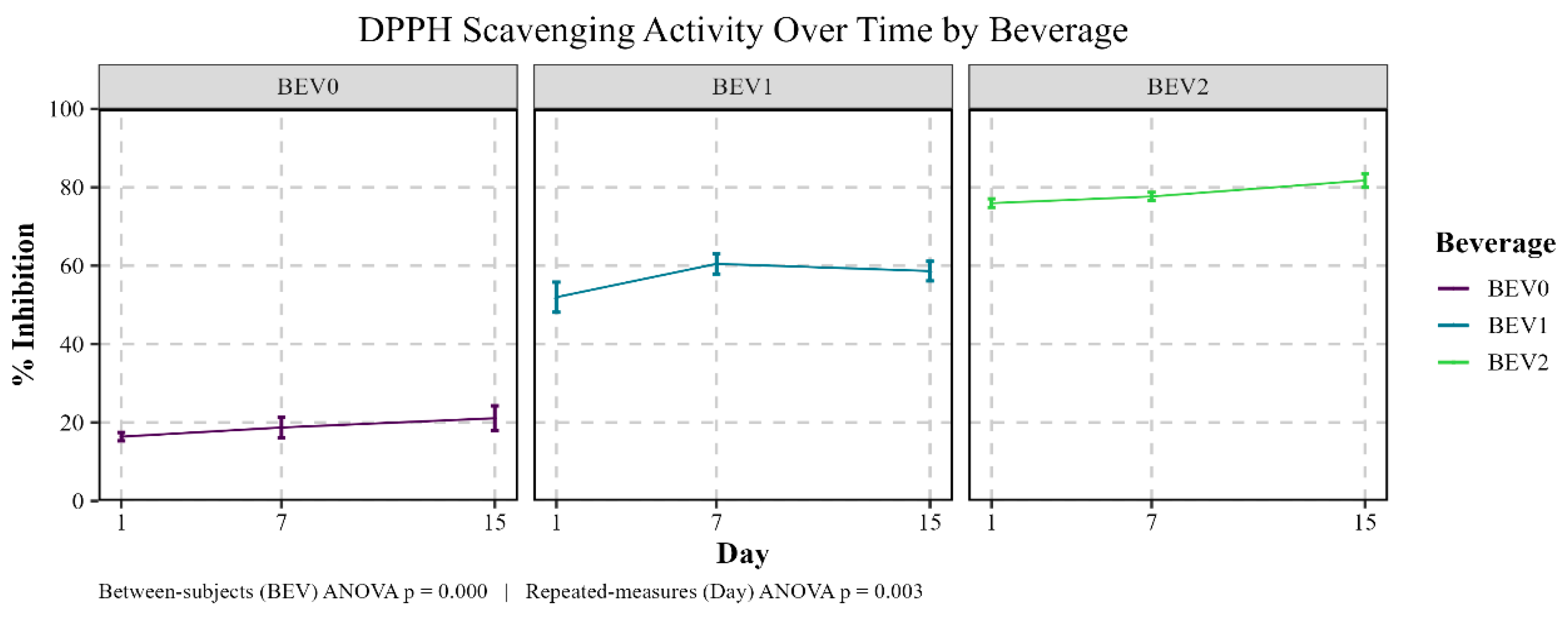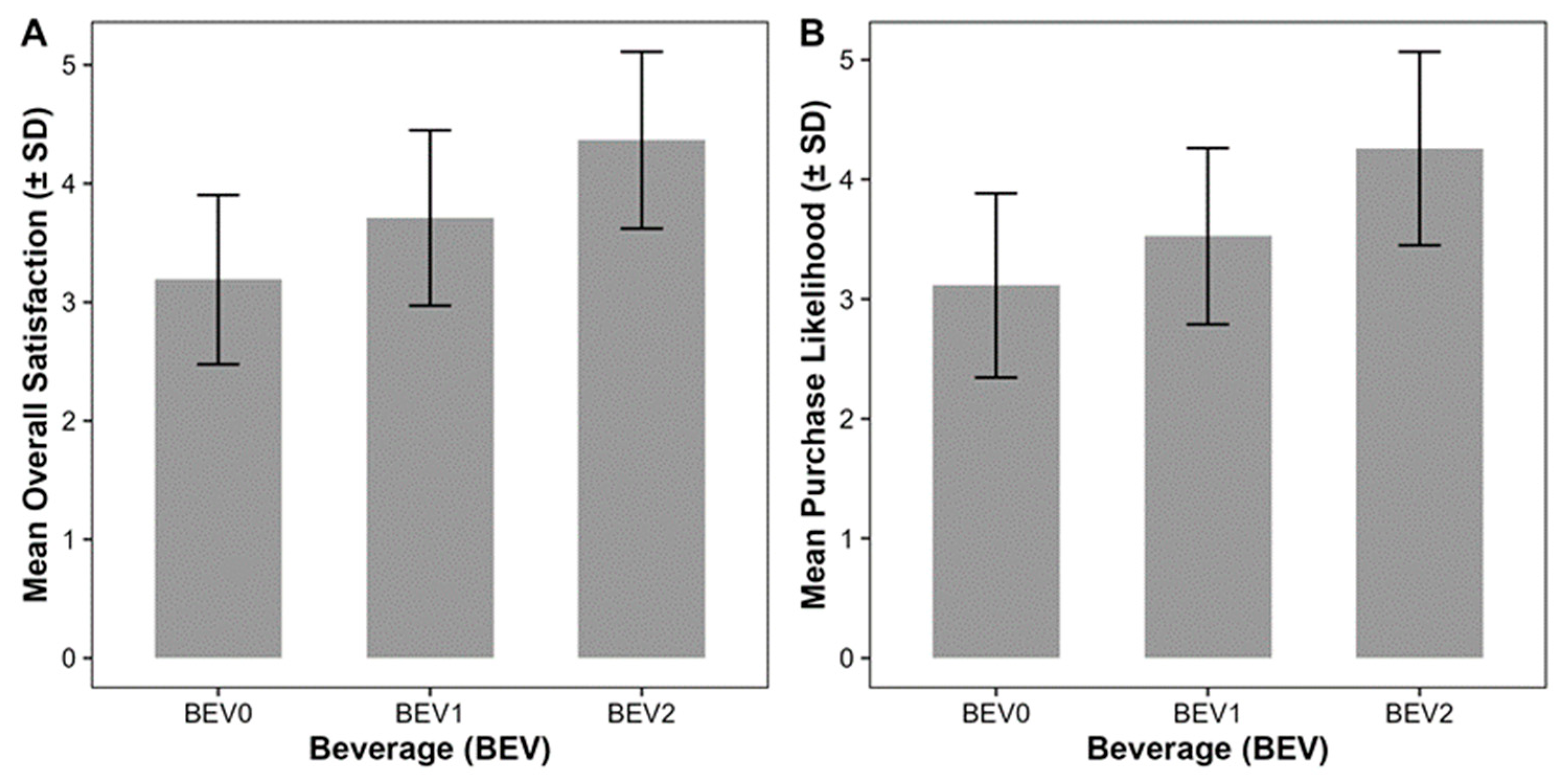Physicochemical Properties and Antioxidant Profile of a Fermented Dairy Beverage Enriched with Coffee By-Products
Abstract
1. Introduction
2. Materials and Methods
2.1. Materials
2.2. Preparation of Dairy Beverage Enhanced with Spent Coffee Grounds Extract
2.3. Physicochemical Characteristics
2.4. Total Phenolic Content
2.5. Antioxidant Capacity Using 2,2-Diphenyl-2-Picrylydrazyl (DPPH) Radical Scavenging Activity Assay
2.6. Sensory Evaluation
2.7. Statistical Analysis
3. Results and Discussion
3.1. Physicochemical Characteristics of Fermented Dairy Beverages Enriched with Coffee By-Products Extract
3.2. Total Phenolic Content of Dairy Beverages Enriched with SCG Extract
3.3. Antioxidant Activity of Dairy Beverages Enriched with SCG Extract
3.4. Sensory Evaluation of Dairy Beverages Enriched with SCG Extract
4. Conclusions
Author Contributions
Funding
Institutional Review Board Statement
Informed Consent Statement
Data Availability Statement
Acknowledgments
Conflicts of Interest
Abbreviations
| SCG | Spent coffee grounds |
| TPC | Total phenolic compound |
| DPPH | 2,2-Diphenyl-1-picrylhydrazyl |
| IC50 | Half-maximal inhibitory concentration |
| GAE | Gallic acid equivalent |
| BEV0 | Goat dairy fermented beverage with 0% SCG extract |
| BEV1 | Goat dairy fermented beverage with 1% SCG extract |
| BEV2 | Goat dairy fermented beverage with 2% SCG extract |
| ISO | International Organization for Standardization |
| LL.4 | Four-parameter logistic model |
References
- Bigliardi, B.; Galati, F. Innovation trends in the food industry: The case of functional foods. Trends Food Sci. Technol. 2013, 31, 118–129. [Google Scholar] [CrossRef]
- Keservani, R.K.; Kesharwani, R.K.; Vyas, N.; Jain, S.; Raghuvanshi, R.; Sharma, A.K. Scholars Research Library Nutraceutical and Functional Food as Future Food: A Review. Pharm. Lett. 2010, 2, 106–116. [Google Scholar]
- Ansori, F.A.Z.; Nisa, F.C.; Mubarok, A.Z. Functional Products Based on Goat Milk with the Addition of Natural Antioxidants: Scientific Review. J. Ilmu Teknol. Has. Ternak 2024, 19, 217–229. [Google Scholar] [CrossRef]
- Kaur, H.; Kaur, G.; Ali, S.A. Dairy-Based Probiotic-Fermented Functional Foods: An Update on Their Health-Promoting Properties. Fermentation 2022, 8, 425. [Google Scholar] [CrossRef]
- Lima, M.J.R.; Teixeira-Lemos, E.; Oliveira, J.; Teixeira-Lemos, L.P.; Monteiro, A.M.C.; Costa, J.M. Nutritional and Health Profile of Goat Products: Focus on Health Benefits of Goat Milk. In Goat Science; Intech: Vienna, Austria, 2018; pp. 189–232. [Google Scholar] [CrossRef]
- Zenebe, T.; Ahmed, N.; Kabeta, T.; Kebede, G. Review on Medicinal and Nutritional Values of Goat Milk. Acad. J. Nutr. 2014, 3, 30–39. [Google Scholar] [CrossRef]
- Lad, S.S.; Aparnathi, K.D.; Mehta, B.; Velpula, S. Goat Milk in Human Nutrition and Health—A Review. Int. J. Curr. Microbiol. Appl. Sci. 2017, 6, 1781–1792. [Google Scholar] [CrossRef]
- Park, Y.W.; Juárez, M.; Ramos, M.; Haenlein, G.F.W. Physico-chemical characteristics of goat and sheep milk. Small Rumin. Res. 2007, 68, 88–113. [Google Scholar] [CrossRef]
- Asresie, A.; Adugna, M. Bioactive Properties of Goat Milk: It’s Hypoallergenic, Nutritional and Therapeutic Significance: A Review Article Info Abstract. Glob. J. Anim. Sci. Res. J. Homepage 2014, 2, 315–320. [Google Scholar]
- Sharma, G.; Rout, P.K.; Kaushik, R.; Singh, G. Identification of Bioactive Peptides in Goat Milk and Their Health Application. Adv. Dairy Res. 2017, 5, 1000191. [Google Scholar] [CrossRef]
- Espejo-Carpio, F.J.; García-Moreno, P.J.; Pérez-Gálvez, R.; Morales-Medina, R.; Guadix, A.; Guadix, E.M. Effect of digestive enzymes on the bioactive properties of goat milk protein hydrolysates. Int. Dairy J. 2016, 54, 21–28. [Google Scholar] [CrossRef]
- Costa, R.G.; Filho, E.M.B.; de Sousa, S.; da Cruz, G.R.B.; Queiroga, R.d.C.R.D.E.; da Cruz, E.N. Physicochemical and sensory characteristics of yoghurts made from goat and cow milk. Anim. Sci. J. 2016, 87, 703–709. [Google Scholar] [CrossRef]
- De Santis, D.; Giacinti, G.; Chemello, G.; Frangipane, M.T. Frangipane Improvement of the Sensory Characteristics of Goat Milk Yogurt. J. Food Sci. 2019, 84, 2289–2296. [Google Scholar] [CrossRef]
- Uysal-Pala, C.; Karagul-Yuceer, Y.; Pala, A.; Savas, T. Sensory properties of drinkable yogurt made from milk of different goat breeds. J. Sens. Stud. 2006, 21, 520–533. [Google Scholar] [CrossRef]
- Jrad, Z.; Oussaief, O.; El-Hatmi, H.; Bouaziz, M.A. Fortification of goat yogurt with roasted date seeds (Phoenix dactylifera L.) powder: Impact on nutritional, technological, phenolic profile, antioxidant and sensory properties. J. Food Meas. Charact. 2022, 16, 4675–4686. [Google Scholar] [CrossRef]
- Bondam, A.F.; da Silveira, D.D.; Santos, J.P.D.; Hoffmann, J.F. Phenolic compounds from coffee by-products: Extraction and application in the food and pharmaceutical industries. Trends Food Sci. Technol. 2022, 123, 172–186. [Google Scholar] [CrossRef]
- Azuan, A.A.; Mohd, Z.Z.; Hasmadi, M.; Rusli, N.D.; Zainol, M.K. Physicochemical, antioxidant and sensory characteristics of cookies supplemented with different levels of spent coffee ground extract. Food Res. 2020, 4, 1181–1190. [Google Scholar] [CrossRef] [PubMed]
- Balzano, M.; Loizzo, M.R.; Tundis, R.; Lucci, P.; Nunez, O.; Fiorini, D.; Giardinieri, A.; Frega, N.G.; Pacetti, D. Spent espresso coffee grounds as a source of anti-proliferative and antioxidant compounds. Innov. Food Sci. Emerg. Technol. 2020, 59, 102254. [Google Scholar] [CrossRef]
- Hasballah, K.; Lestari, W.; Listiawan, M.Y.; Sofia, S. Coffee by-products as the source of antioxidants: A systematic review. F1000Research 2022, 11, 220. [Google Scholar] [CrossRef]
- Iriondo-Dehond, M.; Miguel, E.; Del Castillo, M.D. Food byproducts as sustainable ingredients for innovative and healthy dairy foods. Nutrients 2018, 10, 1358. [Google Scholar] [CrossRef]
- Andrade, C.; Perestrelo, R.; Câmara, J.S. Bioactive Compounds and Antioxidant Activity from Spent Coffee Grounds as a Powerful Approach for Its Valorization. Molecules 2022, 27, 7504. [Google Scholar] [CrossRef]
- Getachew, A.T.; Chun, B.S. Influence of pretreatment and modifiers on subcritical water liquefaction of spent coffee grounds: A green waste valorization approach. J. Clean. Prod. 2017, 142, 3719–3727. [Google Scholar] [CrossRef]
- Xu, H.; Wang, W.; Liu, X.; Yuan, F.; Gao, Y. Antioxidative phenolics obtained from spent coffee grounds (Coffea arabica L.) by subcritical water extraction. Ind. Crops Prod. 2015, 76, 946–954. [Google Scholar] [CrossRef]
- McNutt, J.; He, Q. Spent coffee grounds: A review on current utilization. J. Ind. Eng. Chem. 2019, 71, 78–88. [Google Scholar] [CrossRef]
- Solomakou, N.; Loukri, A.; Tsafrakidou, P.; Michaelidou, A.M.; Mourtzinos, I.; Goula, A.M. Recovery of phenolic compounds from spent coffee grounds through optimized extraction processes. Sustain. Chem. Pharm. 2022, 25, 100592. [Google Scholar] [CrossRef]
- Campos-Vega, R.; Loarca-Piña, G.; Vergara-Castañeda, H.A.; Oomah, B.D. Spent coffee grounds: A review on current research and future prospects. Trends Food Sci. Technol. 2015, 45, 24–36. [Google Scholar] [CrossRef]
- Mussatto, S.I.; Ballesteros, L.F.; Martins, S.; Teixeira, J.A. Extraction of antioxidant phenolic compounds from spent coffee grounds. Sep. Purif. Technol. 2011, 83, 173–179. [Google Scholar] [CrossRef]
- Ramón-Gonçalves, M.; Gómez-Mejía, E.; Rosales-Conrado, N.; León-González, M.E.; Madrid, Y. Extraction, identification and quantification of polyphenols from spent coffee grounds by chromatographic methods and chemometric analyses. Waste Manag. 2019, 96, 15–24. [Google Scholar] [CrossRef] [PubMed]
- Iriondo-DeHond, A.; Casas, A.R.; del Castillo, M.D. Interest of Coffee Melanoidins as Sustainable Healthier Food Ingredients. Front. Nutr. 2021, 8, 730343. [Google Scholar] [CrossRef]
- ISO 19662:2018; Milk-Determination of Fat Content Acido-Butyrometric (Gerber Method). International Organization for Standardization: Geneva, Switzerland, 2018. Available online: https://www.iso.org/standard/65935.html (accessed on 14 June 2025).
- ISO 8968-1:2014; Milk and Milk Products-Determination of Nitrogen Content. International Organization for Standardization: Geneva, Switzerland, 2014. Available online: https://www.iso.org/standard/61020.html (accessed on 14 June 2025).
- ISO 6091:2010; Dried Milk—Determination of Titratable Acidity (Reference Method). International Organization for Standardization: Geneva, Switzerland, 2010. Available online: https://www.iso.org/standard/55777.html (accessed on 14 June 2025).
- Vázquez, C.V.; Rojas, M.G.V.; Ramírez, C.A.; Chávez-Servín, J.L.; García-Gasca, T.; Ferriz Martínez, R.A.; García, O.P.; Rosado, J.L.; López-Sabater, C.M.; Castellote, A.I.; et al. Total phenolic compounds in milk from different species. Design of an extraction technique for quantification using the Folin–Ciocalteu method. Food Chem. 2015, 176, 480–486. [Google Scholar] [CrossRef]
- Du, H.; Wang, X.; Yang, H.; Zhu, F.; Tang, D.; Cheng, J.; Liu, X. Changes of phenolic profile and antioxidant activity during cold storage of functional flavored yogurt supplemented with mulberry pomace. Food Control 2022, 132, 108554. [Google Scholar] [CrossRef]
- Rosas-Nexticapa, M.; Angulo, O.; O’Mahony, M. How well does the 9-point hedonic scale predict purchase frequency? J. Sens. Stud. 2005, 20, 313–331. [Google Scholar] [CrossRef]
- Cardello, A.V. Hedonic scaling: Assumptions, contexts and frames of reference. Curr. Opin. Food Sci. 2017, 15, 14–21. [Google Scholar] [CrossRef]
- Lim, J. Hedonic scaling: A review of methods and theory. Food Qual. Prefer. 2011, 22, 733–747. [Google Scholar] [CrossRef]
- Gomes, J.J.L.; Duarte, A.M.; Batista, A.S.M.; de Figueiredo, R.M.F.; de Sousa, E.P.; de Souza, E.L.; do Egypto, R.D.C.R. Physicochemical and sensory properties of fermented dairy beverages made with goat’s milk, cow’s milk and a mixture of the two milks. LWT-Food Sci. Technol. 2013, 54, 18–24. [Google Scholar] [CrossRef]
- Panzella, L.; Cerruti, P.; Aprea, P.; Paolillo, R.; Pellegrino, G.; Moccia, F.; Condorelli, G.G.; Vollaro, A.; Ambrogi, V.; Catania, M.R.; et al. Silver nanoparticles on hydrolyzed spent coffee grounds (HSCG) for green antibacterial devices. J. Clean. Prod. 2020, 268, 122352. [Google Scholar] [CrossRef]
- Jiménez-Zamora, A.; Pastoriza, S.; Rufián-Henares, J.A. Revalorization of coffee by-products. Prebiotic, antimicrobial and antioxidant properties. LWT-Food Sci. Technol. 2015, 61, 12–18. [Google Scholar] [CrossRef]
- Horita, K.; Kameda, T.; Suga, H.; Hirano, A. Molecular mechanism of the interactions between coffee polyphenols and milk proteins. Food Res. Int. 2025, 202, 115573. [Google Scholar] [CrossRef]
- Rashidinejad, A.; Tarhan, O.; Rezaei, A.; Capanoglu, E.; Boostani, S.; Khoshnoudi-Nia, S.; Samborska, K.; Garavand, F.; Shaddel, R.; Akbari-Alavijeh, S.; et al. Addition of milk to coffee beverages; the effect on functional, nutritional, and sensorial properties. Crit. Rev. Food Sci. Nutr. 2022, 62, 6132–6152. [Google Scholar] [CrossRef]
- Pimpley, V.A.; Maity, S.; Murthy, P.S. Green coffee polyphenols in formulations of functional yoghurt and their quality attributes. Int. J. Dairy Technol. 2022, 75, 159–170. [Google Scholar] [CrossRef]
- Wang, X.; Qi, Y.; Zheng, H. Dietary Polyphenol, Gut Microbiota, and Health Benefits. Antioxidants 2022, 11, 1212. [Google Scholar] [CrossRef]
- Kovalcik, A.; Obruca, S.; Marova, I. Valorization of spent coffee grounds: A review. Food Bioprod. Process. 2018, 110, 104–119. [Google Scholar] [CrossRef]
- Ozdal, T.; Capanoglu, E.; Altay, F. A review on protein–phenolic interactions and associated changes. Food Res. Int. 2013, 51, 954–970. [Google Scholar] [CrossRef]
- Yildirim-Elikoglu, S.; Erdem, Y.K. Interactions between milk proteins and polyphenols: Binding mechanisms, related changes, and the future trends in the dairy industry. Food Rev. Int. 2018, 34, 665–697. [Google Scholar] [CrossRef]
- Chávez-Servín, J.L.; Andrade-Montemayor, H.M.; Vázquez, C.V.; Barreyro, A.A.; García-Gasca, T.; Martínez, R.A.F.; Ramírez, A.M.O.; de la Torre-Carbot, K. Effects of feeding system, heat treatment and season on phenolic compounds and antioxidant capacity in goat milk, whey and cheese. Small Rumin. Res. 2018, 160, 54–58. [Google Scholar] [CrossRef]
- Sarmadi, B.H.; Ismail, A. Antioxidative peptides from food proteins: A review. Peptides 2010, 31, 1949–1956. [Google Scholar] [CrossRef]
- Lorenzo, J.M.; Munekata, P.E.; Gómez, B.; Barba, F.J.; Mora, L.; Pérez-Santaescolástica, C.; Toldrá, F. Bioactive peptides as natural antioxidants in food products—A review. Trends Food. Sci. Technol. 2018, 79, 136–147. [Google Scholar] [CrossRef]
- Stobiecka, M.; Król, J.; Brodziak, A. Antioxidant Activity of Milk and Dairy Products. Animals 2022, 12, 245. [Google Scholar] [CrossRef]
- Panchal, G.; Hati, S.; Darji, V.; Prajapati, J. Antioxidant activities, proteolytic activity and growth behavior of Lactobacillus cultures during fermentation of goat milk. Indian J. Dairy Sci. 2020, 73, 57–66. [Google Scholar] [CrossRef]
- Ahmed, A.S.; El-Bassiony, T.; Elmalt, L.M.; Ibrahim, H.R. Identification of potent antioxidant bioactive peptides from goat milk proteins. Food Res. Int. 2015, 74, 80–88. [Google Scholar] [CrossRef]
- Sah, B.N.P.; Vasiljevic, T.; McKechnie, S.; Donkor, O.N. Effect of refrigerated storage on probiotic viability and the production and stability of antimutagenic and antioxidant peptides in yogurt supplemented with pineapple peel. J. Dairy Sci. 2015, 98, 5905–5916. [Google Scholar] [CrossRef]
- Li, Z.; Jiang, A.; Yue, T.; Wang, J.; Wang, Y.; Su, J. Purification and identification of five novel antioxidant peptides from goat milk casein hydrolysates. J. Dairy Sci. 2013, 96, 4242–4251. [Google Scholar] [CrossRef]
- Ricci, D.; Fraternale, D.; Giamperi, L.; Bucchini, A.; Epifano, F.; Burini, G.; Curini, M. Chemical composition, antimicrobial and antioxidant activity of the essential oil of Teucrium marum (Lamiaceae). J. Ethnopharmacol. 2005, 98, 195–200. [Google Scholar] [CrossRef]
- Montemurro, M.; Casertano, M.; Vilas-Franquesa, A.; Rizzello, C.G.; Fogliano, V. Exploitation of spent coffee ground (SCG) as a source of functional compounds and growth substrate for probiotic lactic acid bacteria. LWT 2024, 198, 115974. [Google Scholar] [CrossRef]
- Li, J.; Streletskaya, N.A.; Gómez, M.I. Does taste sensitivity matter? The effect of coffee sensory tasting information and taste sensitivity on consumer preferences. Food Qual. Prefer. 2019, 71, 447–451. [Google Scholar] [CrossRef]
- Sampaio, A.; Dragone, G.; Vilanova, M.; Oliveira, J.M.; Teixeira, J.A.; Mussatto, S.I. Production, chemical characterization, and sensory profile of a novel spirit elaborated from spent coffee ground. LWT-Food Sci. Technol. 2013, 54, 557–563. [Google Scholar] [CrossRef]






| BEV0 | BEV1 | BEV2 | p-Value * | |
|---|---|---|---|---|
| pH | 3.93 ± 0.01 | 3.95 ± 0.03 | 4.10 ± 0.02 | 0.004 |
| Titratable acidity% | 0.93 ± 0.01 | 0.90 ± 0.01 | 0.86 ± 0.01 | 0.003 |
| Protein content% | 3.46 ± 0.15 | 3.35 ± 0.16 | 3.23 ± 0.19 | 0.066 |
| Fat content% | 3.17 ± 0.12 | 3.07 ± 0.23 | 2.87 ± 0.15 | 0.051 |
| Total Phenolic Content (TPC) | |||
|---|---|---|---|
| Samples | Day 1 (μg GAE/mL) | Day7 (μg GAE/mL) | Day 15 (μg GAE/mL) |
| BEV0 | 45.38 ± 2.31 | 74.14 ± 1.86 | 93.54 ± 2.03 |
| BEV1 | 165.56 ± 2.52 | 195.53 ± 4.63 | 252.56 ±1.15 |
| BEV2 | 245.15 ± 9.53 | 263.54 ± 2.67 | 312.45 ± 5.29 |
| Beverage | Age Group | Satisfaction | p-Value * | Purchase_Likelihood | p-Value * |
|---|---|---|---|---|---|
| BEV0 | ≤25 | 2.92 ± 0.67 | <0.001 | 2.88 ± 0.77 | 0.004 |
| 26–35 | 3.18 ± 0.61 | 3.14 ± 0.71 | |||
| 36–50 | 3.26 ± 0.71 | 3.11 ± 0.7 | |||
| >50 | 3.65 ± 0.69 | 3.54 ± 0.76 | |||
| BEV1 | ≤25 | 3.6 ± 0.7 | 0.058 | 3.40 ± 0.64 | 0.031 |
| 26–35 | 3.57 ± 0.79 | 3.32 ± 0.77 | |||
| 36–50 | 4.04 ± 0.76 | 3.78 ± 0.8 | |||
| >50 | 3.73 ± 0.67 | 3.73 ± 0.72 | |||
| BEV2 | ≤25 | 4.4 ± 0.67 | 0.179 | 4.38 ± 0.64 | 0.059 |
| 26–35 | 4.11 ± 0.88 | 3.89 ± 1.13 | |||
| 36–50 | 4.52 ± 0.51 | 4.33 ± 0.48 | |||
| >50 | 4.42 ± 0.9 | 4.35 ± 0.89 |
Disclaimer/Publisher’s Note: The statements, opinions and data contained in all publications are solely those of the individual author(s) and contributor(s) and not of MDPI and/or the editor(s). MDPI and/or the editor(s) disclaim responsibility for any injury to people or property resulting from any ideas, methods, instructions or products referred to in the content. |
© 2025 by the authors. Licensee MDPI, Basel, Switzerland. This article is an open access article distributed under the terms and conditions of the Creative Commons Attribution (CC BY) license (https://creativecommons.org/licenses/by/4.0/).
Share and Cite
Alexandraki, M.; Maisoglou, I.; Koureas, M.; Kossyva, V.; Tzereme, A.; Meleti, E.; Vrontaki, M.; Manouras, V.; Dimitriou, L.; Malissiova, E.; et al. Physicochemical Properties and Antioxidant Profile of a Fermented Dairy Beverage Enriched with Coffee By-Products. Beverages 2025, 11, 121. https://doi.org/10.3390/beverages11040121
Alexandraki M, Maisoglou I, Koureas M, Kossyva V, Tzereme A, Meleti E, Vrontaki M, Manouras V, Dimitriou L, Malissiova E, et al. Physicochemical Properties and Antioxidant Profile of a Fermented Dairy Beverage Enriched with Coffee By-Products. Beverages. 2025; 11(4):121. https://doi.org/10.3390/beverages11040121
Chicago/Turabian StyleAlexandraki, Maria, Ioannis Maisoglou, Michalis Koureas, Vasiliki Kossyva, Anastasia Tzereme, Ermioni Meleti, Mariastela Vrontaki, Vasileios Manouras, Lamprini Dimitriou, Eleni Malissiova, and et al. 2025. "Physicochemical Properties and Antioxidant Profile of a Fermented Dairy Beverage Enriched with Coffee By-Products" Beverages 11, no. 4: 121. https://doi.org/10.3390/beverages11040121
APA StyleAlexandraki, M., Maisoglou, I., Koureas, M., Kossyva, V., Tzereme, A., Meleti, E., Vrontaki, M., Manouras, V., Dimitriou, L., Malissiova, E., & Manouras, A. (2025). Physicochemical Properties and Antioxidant Profile of a Fermented Dairy Beverage Enriched with Coffee By-Products. Beverages, 11(4), 121. https://doi.org/10.3390/beverages11040121








